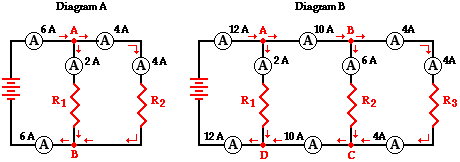Question #85d50
1 Answer
Current is the same along series branches but splits along parallel branches.
Voltage is the same along parallel branches but shared along series branches.
An ammeter is used to measure current. It needs to be in series with the component(s) being analysed so that it measures the current flowing through the component(s).
A voltmeter is used to measure voltage. It needs to be in parallel with the component(s) being analysed so that it measures the potential drop across the component(s).
In addition to the above facts the resistances of the meters affect the circuit. Ammeters are designed to have as low a resistance as possible In series this means it has a negligible effect on the current flowing through the component(s). But in parallel it effectively short circuits it ( current takes path of least resistance ).
Voltmeters are designed to have as high a resistance as possible. In parallel only a tiny amount of current will flow along its branch so it will have a negligible effect on the current in the component. But in series most of the potential drop will be across the voltmeter instead of the component(s) [or it increases the resistance of the branch by so much that the current is drastically reduced through the component].



